MIKROGEN recomBlot HCV IgG 2.0 Hepatitis C Virus
MIKROGEN recomBlot HCV IgG 2.0 Hepatitis C Virus
MIKROGEN recomBlot HCV IgG 2.0 Hepatitis C Virus
Create successful ePaper yourself
Turn your PDF publications into a flip-book with our unique Google optimized e-Paper software.
E<br />
<strong>Hepatitis</strong> C <strong>Virus</strong><br />
<strong>MIKROGEN</strong><br />
molekularbiologische Entwicklungs-GmbH<br />
Western blot<br />
NEW<br />
0483<br />
<strong>recomBlot</strong> <strong>HCV</strong> <strong>IgG</strong> <strong>2.0</strong><br />
Immunoblot test with antigens produced by recombinant technique for the detection<br />
of <strong>IgG</strong> antibodies against the hepatitis C virus (<strong>HCV</strong>)<br />
The most important pathogen responsible for parenterally transmitted non-A, non-B<br />
hepatitis is the hepatitis C virus (<strong>HCV</strong>). This disease is characterized by an incubation<br />
period of 2 - 26 weeks and a mild to fulminant course in the acute phase. 50 - 70 % of<br />
the patients develop chronic hepatitis which leads to liver cirrhosis in 20 % of the<br />
cases. As with hepatitis B, the risk of developing hepatocellular carcinoma is also<br />
greatly increased in the case of a chronic <strong>HCV</strong> infection.<br />
At present, strict indications for the administration of blood products as well as the<br />
screening of blood and plasma donors are the most effective measures to prevent a<br />
<strong>HCV</strong> infection.<br />
<strong>recomBlot</strong> <strong>HCV</strong> <strong>IgG</strong> uses recombinant antigens, which are separated by gel<br />
electrophoresis and transferred to a nitrocellulose membrane (Western blot). Screening<br />
results can be easily and safely confirmed with this test.<br />
React. control<br />
NS-3<br />
Helicase<br />
NS-5-12<br />
NS-4<br />
Core<br />
■ Product Advantages<br />
• Recombinant antigens, therefore<br />
➣ highest sensitivity, specifity and reproducibility<br />
➣ easy and clear interpretation due to easy readable bands<br />
➣ use of five serologically relevant <strong>HCV</strong> antigens<br />
• True Western Blot technique<br />
• Serum incubation is limited to 1 hour<br />
• Save evaluation by cut-off control serum<br />
• Easy evaluation due to band specific point values<br />
• Easy test procedure (automation possible)<br />
• certification by notified body (replace the former PEI accreditiation)<br />
■ Recombinant antigens<br />
Antigen<br />
NS-3<br />
Helicase<br />
R ecombinant Antigen<br />
Size [kDa]<br />
Non-structural<br />
protein with helicase / protease activity<br />
70<br />
Non-structural<br />
protein / part of NS-3 with helicase activity<br />
40<br />
NS-5-12<br />
Non-structural<br />
protein / part of NS-5<br />
30<br />
NS-4<br />
Non-structural<br />
protein / N-terminal part<br />
27<br />
Core<br />
<strong>Virus</strong><br />
capsid / structural protein<br />
14
■ Test Principle and Procedure<br />
1 st Incubation: A test strip loaded with <strong>HCV</strong> antigens is incubated with diluted serum<br />
or plasma in a dish for 1 hour.<br />
Wash 3 times<br />
E<br />
E<br />
E<br />
2 nd Incubation: Peroxidase conjugated anti-human antibodies (<strong>IgG</strong> specific) are<br />
added. Incubate for 45 minutes.<br />
Wash 3 times<br />
Color reaction: 5 - 15 minutes after addition of the coloring solution, insoluble<br />
colored bands develop at the sites on the test strips occupied by<br />
antibodies.<br />
■ Evaluation<br />
Within the certification the <strong>recomBlot</strong> <strong>HCV</strong> <strong>IgG</strong> <strong>2.0</strong> was evaluated by testing of 1137 samples from various sera<br />
panels. The panels included blood donors, <strong>HCV</strong>-positive samples (with positive results by screening assays),<br />
seroconversions and potentially interfering samples.<br />
For the calculation of sensitivity and specifity of the <strong>recomBlot</strong> <strong>HCV</strong> <strong>IgG</strong> <strong>2.0</strong> only clearly determined sera (identified by<br />
consistent comparative assays) were used.<br />
<strong>recomBlot</strong><br />
<strong>HCV</strong> 2. 0<br />
<strong>HCV</strong>-Status well defined<br />
negative<br />
positive<br />
total<br />
negative<br />
605<br />
1*<br />
606<br />
positive<br />
0 300<br />
300<br />
indeterminate<br />
22<br />
1 23<br />
total<br />
627<br />
302<br />
929<br />
*The sample shows weak positive ELISA results, but was consistently negative in confirmation assyas. <strong>HCV</strong>-RNA<br />
determination by polymerase chain reaction was tested positive. It must be pointed out that the <strong>HCV</strong> positive samples<br />
also comprised haemodialysis patients. Several publications describe the fact that <strong>HCV</strong> viraemia can occur without<br />
detection of <strong>HCV</strong> antibodies.<br />
Sensitivity: 99,3% Specifity: 96,5%<br />
■ Storage and Shelf Life<br />
At 4 °C 12 months from the date of production<br />
■ Commercial Product Article No. 4302 <strong>recomBlot</strong> <strong>HCV</strong> <strong>IgG</strong> <strong>2.0</strong><br />
Reagents for 20 determinations<br />
<strong>MIKROGEN</strong> GmbH<br />
Floriansbogen 2-4 · D-82061 Neuried · Germany · Tel.: +49 (0)89 54801-0 · Fax: +49 (0)89 54801-100<br />
Internet: www.mikrogen.de · eMail: mikrogen@mikrogen.de<br />
pirbhce006


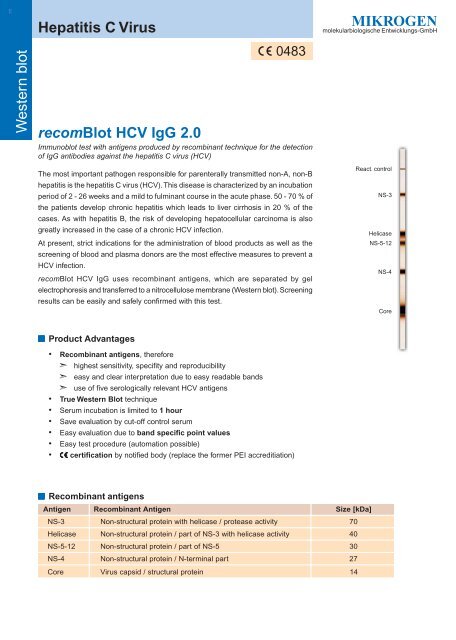

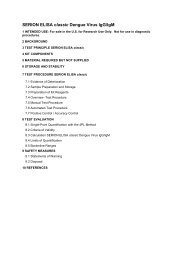
![MIKROGEN recomBlot CMV IgG [Avidity] recomBlot CMV IgM ...](https://img.yumpu.com/47840028/1/185x260/mikrogen-recomblot-cmv-igg-avidity-recomblot-cmv-igm-.jpg?quality=85)
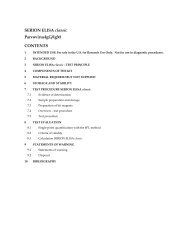
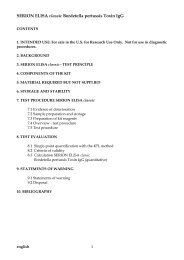
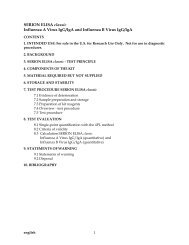

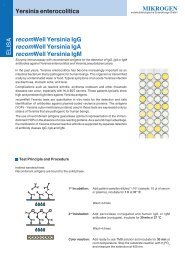
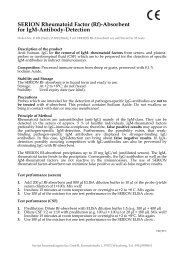

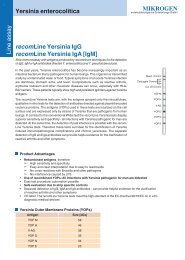
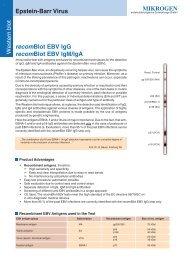
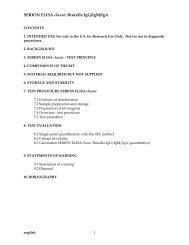
![MIKROGEN recomLine Parvovirus B19 IgG [Avidity] recomLine ...](https://img.yumpu.com/31102785/1/185x260/mikrogen-recomline-parvovirus-b19-igg-avidity-recomline-.jpg?quality=85)